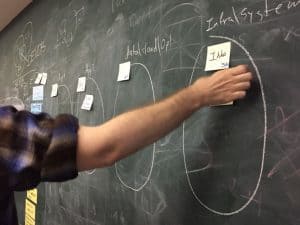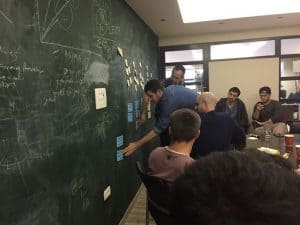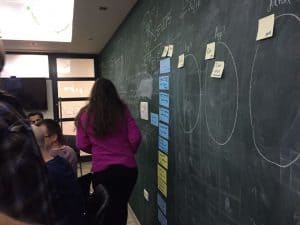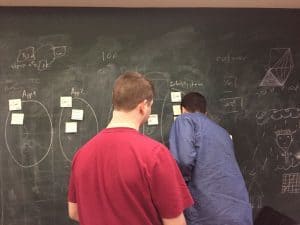- Author: Yael Rabinovich
Lately I had the opportunity and pleasure to facilitate a process of designing cross-functional feature teams in a self-selection process. Self-selection is a facilitated way to let people choose which team to work in. It is surprising how rare this practice is sometimes even considered eccentric while practically it is a simple and fast and produces such great results – well-formed teams with more involved and engaged people.
Why teams self-selection?
It’s a fast engaging process that creates the best conditions for a team to reach high performance.
It’s based on the assumption that with the appropriate context, people will choose to work in a team that they feel will make them be most productive, taking into account the personal relationships with the other team members, the complementary skills they bring, and their aspirations for personal and professional development.
Making the decisions that shape our own future increases our accountability and engagement – we feel respected and valuable when we are actively involved in making decisions, and since we are the ones making the decision, we feel highly committed.
Daniel Pink, in his book “Drive – The Surprising Truth About What Motivates Us”, describes Autonomy, Mastery, and Purpose as the fundamental elements to attain intrinsic motivation, breaking “Autonomy” into four main aspects: time, technique, team, and task. The practice of team self-selection demonstrates people’s autonomy in the team aspect and connects people to a purpose that is bigger than themselves.

How did we do it?
I’m working with a brilliant group that is currently struggling with the process of scaling a successful product and way of work that used to work fine until the group grew and the product became a big complex beast. Following, is a description of how this group used self-selection to design the teams.
Preparations – Leadership buy-in
As we usually do at AgileSparks, in order to kick off the implementation, I facilitated a 2 days of Management Focusing Workshop with the group’s leaders. The wider purpose was to identify key improvements and to shape the road ahead for improving the delivery process. One of the key decisions made in the workshop was to form small cross-functional teams that can own and deliver customer value, end-to-end. During the workshop, we sketched several options for the teams’ formation and discussed the areas the teams need to handle. We discussed the option of self-selection, but the decision to go for it came only a few days later when the leaders had some time to feel more comfortable with the idea.
Defining the guidelines of the process and providing context
The Leaders defined the following guidelines for the self-selection session:
- Small teams (up to 5 people).
- Cross-functional – independently able to deliver features (e.g., contain Backend and UI developers and a QA engineer).
- Team should have a “Goal” or main area (e.g., Infrastructure, Application…).
The following agenda was agreed to for 1.5 hour session:
- Introduction, preparations and guidelines (10 minutes): Present session’s purpose, agenda and guidelines.
- Self assignment round 1 (15 minutes): Each person writes her name on a sticky note and goes to the board, placing the note in the area of the team they wish to be part of, based on the guidelines. During this time, people are allowed to discuss and help each other.
- Review and problem solving (10 minutes): everyone reviews the board displaying the teams’ structure that emerged, discussing the observed challenges and raising potential solutions.
- Self assignment round 2 (10 minutes): Same as round 1. Another opportunity to refine the structure based on the problem solving discussion done earlier.
- Naming the team (10 minutes): Once the structure is balanced and set, each new team convenes and comes up with a name. When ready, each team presents it to everyone.
- Feature allocation (15 minutes): Review the feature backlog and assign main features to the teams.
- Process review and closure (15 minutes): Review the process across teams established so far, (Cross teams planning, Demo, Scrum Of Scrum). The definition of how each team is going to start to work will be done in a dedicated team kick-off session that will be scheduled for the week after.
The Prioritized feature backlog was defined for the first upcoming sprints. This was important in order to create context for the teams and to be able to discuss real examples of what does it mean for the team to be able to deliver end-to-end.
An invite for the session was sent to everyone, scheduled for 1.5 hours.
Teams’ Workshop – introducing the concepts to the teams
We ran a 1 day workshop with all the group, aligning on the guiding Agile\DevOps principles and understanding the way Agile feature-teams serve the goal of reaching high performance. We ran simulations on how this should work. We also communicated the way these teams will be formed in a self-selection process, explained how it will work and when will this session take place.

Self – selection session preparation
Before the session, we prepared the room with sticky notes, wrote the guidelines on the board, drew circles for the teams’ areas and wrote above each circle the assigned Scrum Master. We also placed the feature backlog next to each team area.

Self Selection session – Show time
When the time came, people arrived and sat in front of the board.
The VP R&D described the agenda and the guidelines.
The Product Manager reviewed briefly the feature backlog for the near future, as well as the general challenges and customer focus for the near and medium term future, in order to give people the context that the teams need to operate in.
Then we started the first round of assigning people to teams according to the agenda.
In the first few minutes people were a bit embarrassed, but it took only a short minute after the first brave person wrote her name on a note and placed it on the board. Then other people took sticky notes and wrote their names, stood next to the board, started talking to each other and placing their names where they wanted to be. Some asked clarification questions. Some identified issues and solved them with each other on the fly. The managers mostly sat behind and let people deal with the challenge.

After less than 15 minutes all participants were already sitting, after allocating themselves.


Some discussions were still going on, one of the managers raised a problem about missing some skills in one of the teams. People raised optional solutions.
Surprisingly most of the dilemmas were addressed by the people during the time people assigned themselves. Two people were missing that day from the office for personal reasons, so we had to place them in a team. We agreed that they will get the opportunity to choose a team when they arrive.
The atmosphere was great! We discussed the next steps and scheduled the teams’ kickoffs for the week after.
Leaders briefing
After all the teams left the room, the leaders stayed and discussed how they felt with the process. The feedback was very good and there were not many surprises with the way people assigned themselves, which gave them confidence for the whole process.
The Result
The process was very fast, setting the stage to kick-start the teams with a very positive vibe.
It didn’t guarantee that all the teams will head straight to high performance, but it created much better opening conditions for them to get there.
Summary
In the process of teams self-selection, leadership was, and is still, critical. In the beginning their role was to define the rules and to help in solving conflicts in the process. Beyond that, when the teams are set, leadership’s role is to facilitate the teams’ growth and journey for high performance.
There were many questions and scenarios that leaders were worried about before the session, such as:
- What if everyone wants to be in the same one team?
- What if nobody wants to be in a given team?
- What if things get nasty between people? Will people insult each other?
- What if they don’t get the right combination of seniors and juniors? Not balanced skills?
- What if someone assumes to be having an unrealistic position or skill?
Surprisingly, none of the above happened. I guess people are intelligent and responsible enough.
In case some problem does arise, it’s leadership’s role to help resolving the conflict rather than making the decisions for the teams.
Come to Agile Israel 2017 to hear more on how this process can work in scale in a talk by Em Campbel-Pretty, Author of “Tribal Unity”, Self-Selection: An Agile Approach to Forming Teams @ Scale

